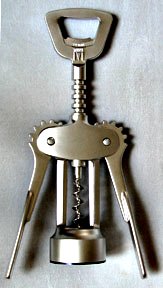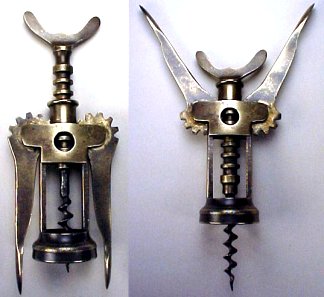

Anthony Longegan: Please find above a picture of a lever corkscrew. I am looking for a detailed description(without referring to a picture) of the construction and operation of this particular corkscrew. I would be very grateful for your help.
Ron: This corkscrew mechanical design was first patented in North America by Italian Dominick Rosati on April 1, 1930 U.S. Patent No. 1,753,026 and November 25, 1930 Canadian Patent No. 306,030.

Your picture illustrates a contemporary satin finish double lever corkscrew manufactured by Monopol® Usbeck & Söhne, Frauenbergerstr., 33 35011 Marburg, Germany. Monopol originally started business in 1879 in Steinbach-Hallenberg in Thuringia, East Germany but moved to West Germany in 1948.
This example has a cast frame with plastic insert to prevent bottle chipping with cast pinion levers with a matching rack on the upper shaft. A crown cork cap lifter is incorporated in the turning handle used to turn the forged web helix worm into a cork. The dual rack & pinion mechanism provides a significant mechanical advantage over a straight pull corkscrew to allow easier cork extraction. The operation is self evident - to extract a cork simply remove the neck wrap, turn the helix into the cork which raises the levers. Press down on the double levers to pull the cork.
With a group of corkscrew collectors I visited the Monopol factory in Marburg last fall (2000) and saw this particular model being fabricated. In my opinion this is a very high quality, possibly the best double lever corkscrew available today - certainly compared to the commonly available and rather poorly made Italian examples which are usually fitted with an archimedean helix.